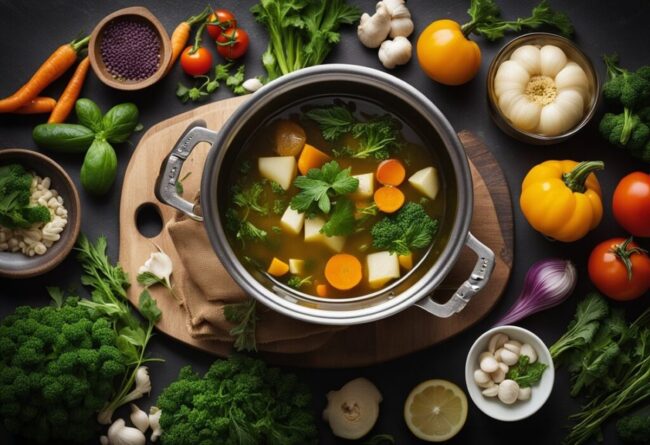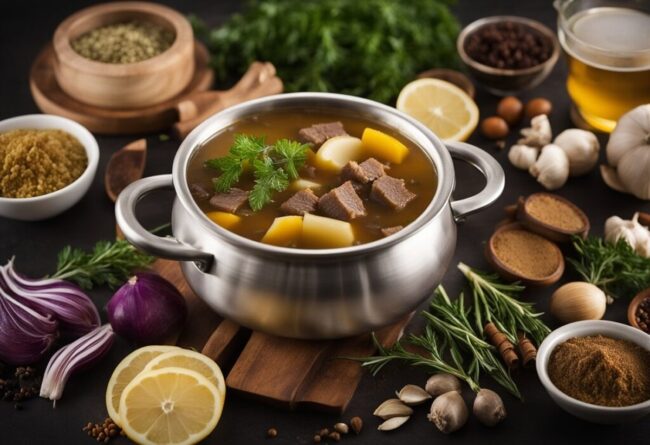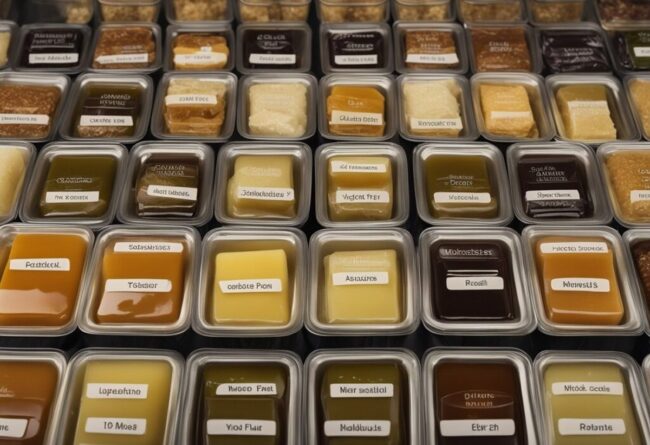11 Flavorful Beef Bouillon Replacements
Beef bouillon provides a rich umami boost to stews, gravies, and sauces, delivering a concentrated meaty flavor.
When an alternative is necessary, broths, stock powders, and seasoning blends can mimic its depth.
Stronger choices intensify the savoriness, whereas lighter options create a more delicate base.
The final selection depends on the dish’s need for richness and salt content.
Beef Bouillon Overview
Beef bouillon is a concentrated seasoning used to enhance soups, stews, and sauces. Its rich, savory flavor adds depth to many dishes.
Beef Bouillon in Cooking
Beef bouillon brings a rich, savory taste to soups, stews, sauces, and even rice dishes.
A compact option for busy cooks or those who want to skip making beef stock from scratch makes it incredibly convenient.
Chefs and home cooks appreciate how easily it fits into their cooking routines while enhancing dishes with a deeper taste.
A concentrated source of beef flavor helps create complex flavors that make every bite satisfying.
Beef Bouillon Ingredients
Understanding the components of beef bouillon helps in using it effectively for richer flavors.
Here are some key parts in this recipe:
Common Beef Bouillon Substitutes
When beef bouillon isn’t available, try others for a similar savory base in your recipes.
Vegetable Broth
A light flavor makes vegetable broth a fantastic choice for those who follow a vegetarian diet.
This adaptable ingredient enhances many dishes without overpowering them.
Creating homemade broth is simple; simmer carrots, celery, onions, and herbs together to develop rich flavors.
For those following a vegan lifestyle or preparing meals for vegans, this option is ideal since it contains no animal products.
Pre-made versions are also available at stores for convenience and ease of use.
Enjoy the flexibility that vegetable broth brings to your cooking adventures!
Chicken Broth
Vegetable or mushroom broth serves as a great alternative for those who do not consume meat.
Chicken broth offers a mild taste that complements numerous dishes, making it suitable for recipes needing less strong flavors.
Homemade chicken broth can be prepared by simmering chicken bones with vegetables and herbs, while pre-made versions are also widely available in stores.
People looking to avoid meat might find chicken broth unsuitable due to its poultry base.
For an easy switch, using vegetable or mushroom options ensures everyone can enjoy flavorful meals without compromising their dietary choices.
Mushroom Broth
A rich, earthy flavor characterizes mushroom broth, making it a great alternative to beef bouillon for anyone avoiding animal products.
Vegetarians and vegans appreciate this flavorful option.
A variety of mushrooms combined with aromatic vegetables and herbs simmered in water creates a delightful homemade version.
For those who prefer convenience, premade mushroom broth is available in many stores.
This versatile ingredient enhances soups and sauces beautifully while adding depth to dishes without meat or dairy.
Enjoying its robust taste can elevate any meal effortlessly.
Beef Broth or Stock
Beef broth or stock serves as an excellent alternative to beef bouillon due to its similar flavor and ingredients.
Homemade versions can be prepared easily by simmering beef bones with vegetables in water, while ready-made options are available in both liquid and powdered forms at stores.
This choice may not fit vegetarian or vegan diets, yet it remains a strong option for those wishing to keep the beef taste intact in their dishes.
Considering these alternatives allows for accommodating different dietary needs while ensuring tasty meals for everyone involved.
Homemade Alternatives
Create homemade alternatives using slow-simmered beef bones, herbs, and vegetables. These options add depth while controlling sodium and preservatives.
Homemade Beef Bouillon
Creating beef bouillon cubes at home involves a few straightforward steps.
Begin by simmering bones along with herbs and vegetables in water for several hours.
Strain the liquid, leaving behind the solids to achieve a clear broth.
Next, thicken this broth in a saucepan until it reaches a concentrated consistency.
Pour the mixture into ice cube trays for freezing, which allows you to portion it easily.
After they freeze solid, move the cubes into a resealable container and keep them in your freezer ready for later use.
This method ensures flavorful additions to your meals whenever needed.
Vegetable Bouillon
A flavorful vegetable bouillon offers a great vegetarian choice.
Start with a mix of your favorite vegetables, such as onions, tomatoes, carrots, celery, and bell peppers.
Finely chopped veggies should be sautéed with herbs like thyme and oregano to enhance the taste.
After cooking them briefly in water to extract flavors, straining the mixture yields a rich liquid base for soups or sauces.
For easy storage options, consider freezing this broth in ice cube trays or drying it out on low heat until it’s crisp before grinding into granules using a food processor.
This versatile ingredient adds depth to many dishes without meat.
Bone Broth
Homemade bone broth serves as a flavorful and nutritious addition to meals.
To prepare it, gather bones from beef, chicken, or pork along with vegetables like carrots, celery, and onions.
Roasting these ingredients in the oven until they turn golden enhances their taste.
Once roasted, transfer them to a large stockpot and cover with water.
A long simmering time of 12 to 48 hours allows flavors to develop fully; straining the liquid completes the process.
Freezing portions in ice cube trays offers convenient access for future cooking adventures while providing an alternative to store-bought bouillon cubes for soups and sauces.
Specialty Substitutes and Flavors
Explore specialty substitutes for a unique twist on beef bouillon’s deep, umami flavor.
Umami-Enhancing Additives
Umami-rich ingredients can elevate the flavor of your dishes when beef bouillon is not available.
Soy sauce serves as a popular choice, providing salty and tangy notes.
Miso paste, known for its use in Japanese cooking, contributes a savory richness with less saltiness than soy sauce, making it quite adaptable.
Tomato paste offers subtle sweetness along with depth and works well in gluten-free recipes.
Liquid aminos deliver an umami-packed taste similar to soy sauce but usually contain less salt and are also gluten-free.
Adjusting the amounts of these ingredients based on personal preference ensures balanced flavors in your meals.
Herbs and Spices as Flavor Agents
Adding herbs and spices introduces distinct flavors to your meals, enhancing the overall taste experience.
These ingredients serve as excellent alternatives or companions to traditional umami boosters.
Creativity plays a key role in experimenting with various combinations tailored to personal tastes.
Many options exist for mixing different seasonings, allowing each dish to shine in its own way.
By using these flavorful additions, it's possible to craft satisfying meals without depending on beef bouillon or similar products.
Embracing this variety opens up new culinary avenues for anyone looking to elevate their cooking game.
Substitutes for Dietary Preferences
Need a beef-free option? These options can provide plant-based umami flavors for various dietary needs.
Vegan and Vegetarian-Friendly Options
Numerous vegan and vegetarian substitutes exist for beef bouillon, each offering a tasty alternative.
Vegetable stock stands out as the most popular choice, bringing a similar depth of flavor while catering to plant-based diets.
Available in stores or easily homemade with fresh vegetables, it provides versatility in various dishes.
Nutritional yeast serves another great option, delivering a savory umami taste that enhances recipes beautifully.
Mixing it with water or vegetable stock creates a flavorful base perfect for soups and sauces.
These options ensure delicious meals without compromising dietary preferences.
Reduced Sodium and Health-Conscious Choices
Exploring various substitutes can help cater to specific dietary needs.
Low-sodium vegetable stock and broths are available in many stores, offering a healthier choice for those mindful of their sodium intake.
Nutritional yeast serves as another great option, adding depth to dishes without excessive salt.
For a lighter touch, herb-infused water or lemon juice mixed with water offers flavor while keeping calories low.
Traditional beef bouillon may lack some richness when replaced by these alternatives, yet the right choices ensure satisfying recipes that meet health goals.
Always consider personal preferences when selecting substitutes for cooking needs.
Substitutes in Different Recipes
Using bouillon substitutes in recipes helps maintain flavor while adjusting for dietary needs. Choosing the right alternative ensures a well-balanced dish.
Changing Recipes with Substitutes
Selecting the right substitute for beef bouillon enhances your dishes.
The choice of ingredient can significantly influence taste, consistency, and overall flavor profile.
Broths like vegetable, chicken, or mushroom bring their own distinct tastes to recipes; adjusting seasonings becomes necessary to maintain balance.
Sodium levels vary widely among substitutes; options such as soy sauce and miso paste contain high amounts of salt, so reducing added salt is wise when using them.
For liquid needs in soups or stews, replacing each cup of beef bouillon with an equal amount of broth works well.
Personal preference plays a key role in finding the perfect match for any dish you prepare; tasting throughout the cooking process ensures delicious results every time.
Keeping Texture and Consistency
Achieving the right texture is crucial when using substitutes for beef bouillon.
Adjusting liquid amounts plays a significant role; if broth is your choice, cut back on any extra liquids in your recipe to keep soups or sauces thick.
Adding thickening agents like cornstarch or arrowroot powder can enhance sauces and gravies, creating a satisfying consistency.
Letting soups or sauces simmer longer helps deepen flavors and thicken dishes when using lighter alternatives such as vegetable broth.
With attention to flavor and texture, adapting recipes becomes an easy task that caters to individual tastes and dietary choices.
Tips and Tricks
Cooking tips for bouillon-based dishes focus on balancing saltiness and depth. Proper dilution and seasoning adjustments create the best results.
Boosting Flavor Richness
Cooking relies heavily on rich flavors to create memorable meals.
Enhancing the aroma of dishes makes each bite more enjoyable.
Vegetable broth serves as a versatile option that brings a hearty taste when beef bouillon is not available, especially if you choose a low-sodium variety for better control over salt levels.
Soy sauce stands out as an umami-rich alternative, bringing savory notes in equal parts without overpowering other ingredients.
Herbs and spices like thyme, sage, or rosemary add layers of flavor and can be adjusted based on personal preference for an even more satisfying dish.
These substitutions ensure depth in every meal while maintaining its essence.
Best Cooking Methods
Mastering cooking techniques can greatly enhance the flavor and aroma of your meals.
Slow-cooking tougher cuts of meat in a tasty liquid results in tenderness while enriching the overall taste.
Adding layers of flavor starts with sautéing aromatic ingredients like onion or garlic, which sets a strong foundation for your dish.
After browning ingredients, deglazing the pan with wine or broth helps release flavorful bits stuck to the bottom, adding complexity to every bite.
Experimentation is key; adjusting spices and methods allows for personalization that elevates each recipe’s unique profile.
Overall, refining these skills will lead to more delicious outcomes in your cooking adventures.




